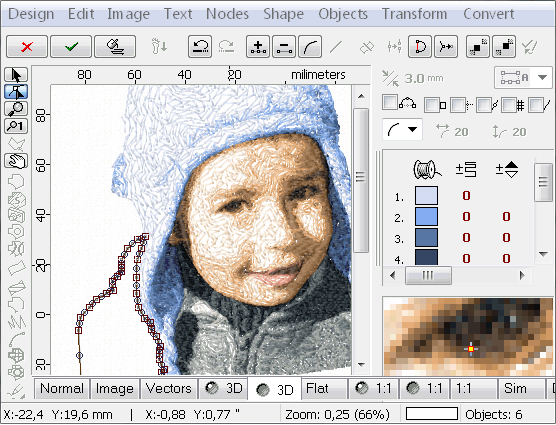Expert Digitizing for Embroidery: Fast and Reliable Solution
Wiki Article
Streamlining the Art of Embroidery Digitizing: Step-by-Step Overview
As innovation continues to advance, the digitization procedure has actually become extra obtainable, permitting lovers to bring their elaborate layouts to life with convenience. In this overview, we will certainly decipher the intricacies of embroidery digitizing, breaking down each step methodically to improve the procedure and empower both newbies and experienced embroiderers alike.Understanding Embroidery Digitizing Software Program
Needlework digitizing software application works as a critical tool for changing elaborate designs into digital formats compatible with needlework machines, facilitating exact stitching and personalization. This customized software application allows users to import numerous image file layouts, such as JPG or PNG, and convert them into embroidery machine-readable formats like DST, EXP, or PES - Digitizing for Embroidery. By making use of features like stitch modifying, underlay alternatives, and string color selection, digitizing software program makes it possible for customers to manage every aspect of the style processFurthermore, progressed needlework digitizing software supplies devices for developing intricate designs, changing stitch thickness, and incorporating detailed information. Users can additionally preview the design prior to sewing it out, making certain accuracy and reducing errors. In addition, numerous software programs give automatic attributes that help simplify the digitizing procedure, saving time and effort.
Comprehending the capacities of needlework digitizing software application is crucial for accomplishing top notch cause embroidery tasks. By grasping this device, embroidery fanatics and experts can release their creativity and bring complex styles to life with accuracy and effectiveness.

Choosing the Right Layout File
After familiarizing on your own with the abilities of embroidery digitizing software program, the following vital step in the procedure is choosing the right style documents for your project. Digitizing for Embroidery. When choosing a design data for embroidery digitizing, it's necessary to consider the complexity of the layout, the size of the last item, and the kind of material you will be functioning withFor intricate styles with fine information, a high-resolution photo or vector documents is recommended to ensure that the embroidery device can properly recreate the style. Additionally, the dimension of the final product plays a considerable function in picking the best layout file. Larger layouts may need greater resolution documents to keep quality and intensity.
In addition, the kind of textile you will certainly be embroidering on influences the option of design file. Various textiles might need changes in the layout data to make certain that the stitches are appropriately lined up and the design appears as intended. By carefully selecting the ideal design documents based upon these variables, you can establish on your own up for a successful needlework digitizing process.
Digitizing Tools and Methods
Using specialized software program and precision strategies, digitizing tools are vital in changing complex designs right into embroidery-ready files. Needlework digitizing software application, such as Wilcom, Hatch, or Embrilliance, supplies the required system to transform artwork right into stitch information. These programs supply features like stitch editing, rug options, and lettering tools why not try these out to guarantee the layout converts perfectly onto fabric.One of the essential techniques in digitizing is developing a clear course for the needlework machine to comply with. This involves digitizing each component of the style with precision, figuring out stitch types, densities, and directions. By utilizing devices like digitizing tablets or software-specific plugins, embroiderers can attain a high degree of accuracy in their digitized designs.
Additionally, mastering the art of underlay stitching is crucial for creating high quality needlework. Underlay stitching supports the fabric and produces a foundation for the layout, guaranteeing that the end product is both aesthetically enticing and long-lasting. By recognizing these digitizing devices and strategies, embroiderers can raise their craft and bring intricate layouts to life with accuracy and effectiveness.
Personalizing Stitch Types and Directions
Having established a foundation in digitizing devices and techniques, an important facet in advancing embroidery craftsmanship lies in tailoring stitch types and directions with accuracy and function. The option of stitch types can significantly affect the general appearance and appearance of the stitched layout. Satin stitches, recognized for their smooth and glossy surface, job well you could try these out for developing borders and message. On the other hand, fill stitches are excellent for covering larger areas successfully. By purposefully incorporating these stitch types, embroiderers can attain deepness and dimension in their styles.Additionally, the instructions of stitches plays a crucial role in improving the visual appeal of the last needlework. By experimenting with various stitch angles and patterns, embroiderers can bring their styles to life with exceptional detail and complexity.
Screening and Refining Your Digitized Style
To make sure the precision and top quality of your digitized layout, comprehensive screening and improvement are crucial action in the needlework digitizing procedure. As soon as you have completed the digitization of your layout, it is critical to test it prior to waging the actual embroidery. Testing permits you to determine any kind of potential problems such as string breaks, sew thickness troubles, or style distortions that may influence the result.
After testing, it is important to improve your digitized style based on the comments from the test sew-out. This may involve tweaking stitch setups, adjusting thickness, or making modifications to the general style to attain the wanted end result. By iterating with testing and improvement, you can fine-tune your digitized style to excellence prior to moving on with the actual needlework procedure.
Conclusion
To conclude, mastering the art of needlework digitizing requires a detailed understanding of the software, picking the ideal design file, making use of digitizing devices and strategies, personalizing stitch types and instructions, and testing and improving the digitized layout. By complying with these steps, embroiderers can simplify the digitizing procedure and produce top quality stitched designs with precision and efficiency.Report this wiki page